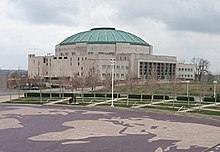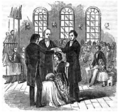|
Welcome to the portal of The Latter Day Saint movement
Introduction The Latter Day Saint movement (also called the LDS movement, LDS restorationist movement, or Smith–Rigdon movement) is the collection of independent church groups that trace their origins to a Christian Restorationist movement founded by Joseph Smith in the late 1820s. Collectively, these churches have over 17 million nominal members, including over 17 million belonging to the Church of Jesus Christ of Latter-day Saints (LDS Church), 250,000 in Community of Christ, and several other denominations with memberships generally ranging in the thousands of members. The predominant theology of the churches in the movement is Mormonism, which sees itself as restoring again on Earth the early Christian church; their members are most commonly known as Mormons. An additional doctrine of the church allows for prophets to receive and publish modern-day revelations. A minority of Latter Day Saint adherents, such as members of Community of Christ, have been influenced by Protestant theologies while maintaining certain distinctive beliefs and practices including continuing revelation, an open canon of scripture and building temples. Other groups include the Remnant Church of Jesus Christ of Latter Day Saints, which supports lineal succession of leadership from Smith's descendants, and the more controversial Fundamentalist Church of Jesus Christ of Latter-Day Saints, which defends the practice of polygamy. (Full article...) General images -The following are images from various Latter Day Saint movement-related articles on Wikipedia.
Selected articleLaie Hawaii Temple is a temple of the Church of Jesus Christ of Latter-day Saints located on the northeast shore of the Hawaiian island of Oʻahu. The temple sits on a small hill, half a mile from the Pacific Ocean, in the town of Lāʻie, 35 miles (56 km) from Honolulu. Along with Brigham Young University–Hawaii and the Polynesian Cultural Center, the Laie Hawaii Temple plays an important role in the town of Lā'ie, with the Visitors' Center attracting more than 100,000 people annually. In addition to initial building and construction, the temple has been dedicated for use by several church presidents. The temple site was dedicated by Joseph F. Smith on June 1, 1915, with Heber J. Grant dedicating the completed structure on November 27, 1919. Spencer W. Kimball rededicated the temple after significant expansion on June 13, 1978. Following seismic upgrades and remodeling, Thomas S. Monson rededicated the temple on November 21, 2010. (Full article...) Selected location The Auditorium (formerly the RLDS Auditorium) is a house of worship and office building located on the greater Temple Lot in Independence, Missouri. The Auditorium is part of the headquarters complex of Community of Christ which also includes the Independence Temple. (Full article...)
Selected schismatic historiesThe Church of Jesus Christ (Cutlerite) is a denomination of the Latter Day Saint movement headquartered in Independence, Missouri, United States. The church derives its epithet from its founder, Alpheus Cutler, a member of the Nauvoo High Council and of Joseph Smith's Council of Fifty. Cutler justified his establishment of an independent church organization by asserting that God had "rejected" Smith's organization—but not his priesthood—following Smith's death, but that Smith had named Cutler to a singular "Quorum of Seven" in anticipation of this event, with a unique prerogative to reorganize the church that no one beyond this group possessed. Hence, Cutler's organization claims to be the only legitimate Latter Day Saint church in the world today. Currently, it has only one branch, located in Independence. The Cutlerite church retains an endowment ceremony believed to date to the Nauvoo period, practices the United Order of Enoch, and accepts baptism for the dead, but not eternal marriage or polygamy. (Full article...) OutlinesRelated portalsKey biographiesJoseph Smith (December 23, 1805 – June 27, 1844) was an American religious leader and the founder of the Latter Day Saint movement whose current followers include members of the Church of Jesus Christ of Latter-day Saints, the Community of Christ, and other Latter Day Saint denominations. The early life of Joseph Smith covers his life from his birth to the end of 1827. Smith was born in Sharon, Vermont, the fifth of eleven children born to Joseph and Lucy Mack Smith. By 1817, Smith's family had moved to the "burned-over district" of western New York, an area repeatedly swept by religious revivals during the Second Great Awakening. Smith family members held divergent views about organized religion, believed in visions and prophecies, and engaged in certain folk religious practices typical of the era. Smith briefly investigated Methodism, but he was generally disillusioned with the churches of his day. (Full article...)
Selected image The Mesoamerican setting of the Limited geography model.
Did you know (auto generated)
Selected Anniversaries
Selected quote
TopicsFeatured contentCategoriesWikiProjectsAssociated WikimediaThe following Wikimedia Foundation sister projects provide more on this subject:
Discover Wikipedia using portals | ||||||||||





































